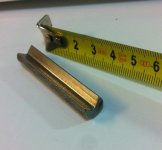timopen
Plastic
- Joined
- Apr 23, 2013
- Location
- Finland, Kouvola
Hi,
hopefully the topic of this thread is not meaningless, but I didn't figure out better one.
So here's the picture of the parts I made about a year ago.

Material is round stock diameter of 10mm and one quarter is milled away, length is 50 mm. Material was some ferritic heat resistant steel. Dimensions are not so critical... these are going to be welded.
I made 2200 pcs. First cut stock to pieces with ~1m lenght, then clamped to milling machine using 4 similar cheap drill vises, and cut the quarter off. I tilted the head to 45 degrees and used 100mm diameter shoulder mill with apkt-inserts. Then put 18 milled stocks together and sawed to 50mm pieces.
The milling and sawing took about 40 hours... Then I had idea that I'll build a rotary tumbling machine using couple of plactic buckets (thanks for youtube :-), yeah... but I't really didn't work out so I endend up grinding the edges... I think it took about 12 hours, but it's not so important.
Well since this job I've had an idea of building a special machine for making these... but there's many buts here... So first of all, could these be made using lathe with live tooling or will there be issues with too much hangout of the stock? So with swiss type lathe the stick out wouldn't be problem?... maybe there's a problem with live tooling and reaching close to spindle? So if it's possible, could you estimate cycle time for one piece?
Other buts are about how much is yearly usage and so on... but those are mainly the things I have to deal with the customer (if this leads to something at some point). But let's say hypothetically that the usage might be 50 000 ... 100 000 pcs/year. So any thought about other considerable manufacturing processes are interesting (for example I thought about cold forging from 8mm stock).
Best Regards
Timo
hopefully the topic of this thread is not meaningless, but I didn't figure out better one.
So here's the picture of the parts I made about a year ago.

Material is round stock diameter of 10mm and one quarter is milled away, length is 50 mm. Material was some ferritic heat resistant steel. Dimensions are not so critical... these are going to be welded.
I made 2200 pcs. First cut stock to pieces with ~1m lenght, then clamped to milling machine using 4 similar cheap drill vises, and cut the quarter off. I tilted the head to 45 degrees and used 100mm diameter shoulder mill with apkt-inserts. Then put 18 milled stocks together and sawed to 50mm pieces.
The milling and sawing took about 40 hours... Then I had idea that I'll build a rotary tumbling machine using couple of plactic buckets (thanks for youtube :-), yeah... but I't really didn't work out so I endend up grinding the edges... I think it took about 12 hours, but it's not so important.
Well since this job I've had an idea of building a special machine for making these... but there's many buts here... So first of all, could these be made using lathe with live tooling or will there be issues with too much hangout of the stock? So with swiss type lathe the stick out wouldn't be problem?... maybe there's a problem with live tooling and reaching close to spindle? So if it's possible, could you estimate cycle time for one piece?
Other buts are about how much is yearly usage and so on... but those are mainly the things I have to deal with the customer (if this leads to something at some point). But let's say hypothetically that the usage might be 50 000 ... 100 000 pcs/year. So any thought about other considerable manufacturing processes are interesting (for example I thought about cold forging from 8mm stock).
Best Regards
Timo




